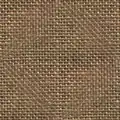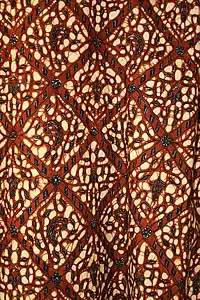Grosgrain
Grosgrain (/ˈɡroʊɡreɪn/, GROH-grayn, also sometimes pronounced /ˈɡrɒsɡreɪn/, GRAHS-grayn), is a type of fabric or ribbon defined by the fact that its weft is heavier than its warp, creating prominent transverse ribs. It is called a "corded" fabric since the weft resembles a fine cord. Grosgrain is a plain weave corded fabric, with heavier cords than in poplin but lighter than in faille.[1][2] Grosgrain has a very dull appearance with little luster but is very strong.[3] It is a firm, close-woven, fine-corded fabric.[4] Grosgrain fabric is most commonly available in black, but grosgrain ribbon comes in a large variety of colors and patterns. The ribbon is very similar to Petersham ribbon in its appearance, but it does not have the ability to follow the curves of a surface or edge the way that the latter does.


"Grosgrain" is commonly used to refer to a heavy, stiff ribbon of silk or nylon[5] woven via taffeta weave using a heavy weft which results in distinct transverse ribs. Historically grosgrain was made from wool, silk, or a combination of fibers such as silk and wool or silk and mohair.[1] When a combination of fibers was used, the end result was sometimes given the name grogram, silk mohair, gros de Tours or gros de Napels.[1][6][7]
Etymology
Grosgrain is both a direct French loan word and a folk corruption of the French word grogram.[8] Grogram, originally gros gram (appeared in literature in 1562), is defined as a coarse, loosely woven fabric of silk, silk and mohair, or silk and wool.[9] The adjective gros means thick or coarse, originally from the Old French gros, itself derived from the Latin grossus.[10]
"Grain" is derived from Old French graine, itself derived from the Latin grana (plural of granum) – seed or in some contexts texture.[4][11]
Thus gros gram, grogram and grosgrain are all one and the same: a large grain hence coarse texture, thence a coarse-textured fabric.[10][12]
The term 'Grog', meaning alcohol, comes from the nickname 'Old Grog', given to Admiral Vernon (1684–1757) because of the grogram cloak he wore.[13]
Moire
Moire is a waved or watered effect produced especially on grosgrain silk and woolen moreen via engraved rollers and high pressure on carded material. The end result is a peculiar luster which works best when made from a corded fabric like grosgrain.[14]
During the Middle Ages, moire was held in high esteem and was, as currently, used for women's dresses, for capes, and for facings, trimmings, etc.[15]
Use in clothing
History
Throughout the 17th century, grosgrain fabric was used as the fabric body (corpus) for many garments, including waistcoats, jackets, petticoats, beeches, sleeves, jerkins and many other items of clothing, as a cheaper alternative for the lower socio-economic demographic than fine-woven silk or wool.[16] In the 1740s Admiral Edward Vernon, who was known as "Old Grog" because he preferred a grosgam cloak to a more expensive variety, introduced the Rum ration in the British Royal Navy. It's from his attire that the naval term grog is derived.[17][18][19] Factories in America started to produce grosgrain silk in the late 19th century.[20][21]
Throughout the 1920s the term seems to have remained true to original definition as a garment fabric.[22] However, circa 1920s it fell out of favor as a garment fabric and was defined identically to contemporary terminology as a grosgrain ribbon. While grosgrain fabric is almost always black, grosgrain ribbon comes in a large variety of colors and printed patterns.
The most common contemporary use of ribbed grosgrain is in hems where it may be elasticized or not, especially of polo shirts, T-shirts and underwear.
Grosgrain that does have some luster is a very popular fabric especially for ribbons, which are used to ornament and decorate clothing. As grosgrain has less luster than burnished silk or satin it is very popular with and common in evening wear because it is seen as less "flashy", though silk and satin (which is a different weave, as opposed to a fiber such as silk) can commonly be found on day wear. Although grosgrain may actually be made of silk, it is often erroneously referred to as a separate fabric.
Structural uses
Lustrous grosgrain is used extensively to join female semi-detached clothing articles such as bodices to skirts and similar, where this necessary joint may be visible.[23] Ribbed grosgrain may be used similarly to twill tape for internal gussets and reinforcements. Grosgrain ribbon is often used for facings and for waistbands.[24][25] Using a grosgrain ribbon facing for waistbands is faster and uses less fabric. It is also works especially well with bulky fabrics.[25]
McCall's Sewing Book states: "grosgrain ribbon is used with any heavy fabric to reduce bulk" though it may be the word "bulk" is used in the sense of outward appearance, rather than actual mass. McCall elaborates: "grosgrain is used to finish the back of novelty braid or to face the back of any fabric belt."[24][25][26]
Evening wear
As a more subtle option to lustrous satin, grosgrain is very popular with evening wear, used on the facings of lapels of most dress coats and high-end dinner jackets and tuxedos. Grosgrain is traditionally used to hem and highlight the cut of lapel, collar and visible outermost edges of the formal frock coat and the later morning coat.[27] Hemmed frock-coats, as described, may be seen in the film Gone with the Wind noted for its historically accurate costume.[28] Grosgrain is preferred over satin for practicality—it does not wear as easily as delicate silk or satin, as the threads do not snag as easily (on a ring or keys, for instance).[29] Grosgrain is also used for matching accessories such as bow ties[29] and cummerbunds, though these are often in barathea to complement the main suiting while still avoiding the glare of satin, increasingly gaining a 'flashy' image.
Other uses
Book-binding
Grosgrain fabric and ribbon are common structural fabrics for the joining or reinforcement of spines or sheaves in fine commercial and hobby book-binding and book restoration.[31]
Cargo and packing use
A particular characteristic of grosgrain ribbon is that the thicker weft resists longitudinal curling and so it exerts an even pressure when tied around crushable materials. Nylon grosgrain is often used as heavy-duty webbing or binding around luggage, packs, messenger bags and other heavy use "soft" goods. It is also used for securing cargo. It can be dyed and is available in a variety of colours (though again usually black).
Early seat belts and military webbing of every sort during World War II were made of grosgrain hemp, jute and linen.
Craft
Grosgrain made out of cotton or low-cost synthetic such as polyester is very common for gift-wrap ribbons, or for decorating and ornamenting scrapbooks and greeting cards. It can be used for many different crafts as well, from bead making,[5] to book-binding,[31] to trimming or embellishing,[32] as well as a multitude of other uses. Grosgrain ribbon is the primary ribbon material used in the hair bow industry.
Lanyards
Grosgrain out of cotton or low-cost synthetic such as polyester is very popular for use as a lanyard, and is often printed on by large corporate companies to use as a marketing or branding tool to promote their companies.
Percussion
Polyester grosgrain in a 5/8-inch width can be used as the tensioning material attaching the snares of a snare drum to the throw-off mechanism, with the ribbing providing good insurance against slippage. Some like to use it in an attempt to lessen sympathetic snare buzz from external sources as it will hold the tab ends of the snares closer to the head than string and it will provide more dampening than mylar straps.
References
- Montgomery, Florence M.; Linda Eaton (2007). Textiles in America, 1650-1870. W. W. Norton & Company. p. 252. ISBN 978-0-393-73224-5. Retrieved July 10, 2009.
- Kate Heinz Watson, Textiles and Clothing American School of Home Economics, Chicago: 1907: pp 91
- Banner, Bertha (1898). Household Sewing with Home Dressmaking. Longmans, Green, and co. p. 106. Retrieved July 10, 2009.
- Thompson, Eliza Bailey (1922). Silk. The Ronald press company. pp. 134–135. Retrieved July 10, 2009.
- Lockwood, Georgene (1998). The Complete Idiot's Guide to Crafts With Kids. Alpha Books. p. 86. ISBN 0-02-862406-8. Retrieved July 10, 2009.
- Cole, George S. (1892). A Complete Dictionary of Dry Goods and History of Silk, Cotton, Linen, Wool. W.B. Conkey Co. p. 171. Retrieved July 10, 2009.
- Cheney Brothers, James Chittick, Emanuel Anthony Posselt, Berlitz Schools of Languages, A glossary of silk terms, including a short history of silk: its origin, culture and manufacture Cheney Brothers: 1915
- Joseph Shipley, Origins of English Words, JHU Press: 2001 ISBN 0-8018-6784-3, 671 pages: pp 121
- Merriam-Webster's collegiate dictionary, Merriam-Webster Inc: pp 551
- Ernest Weekley, An Etymological Dictionary of Modern English, Courier Dover Publications: 1967, ISBN 0-486-21873-2: pp 668
- "Grosgrain". The Oxford English Dictionary. 2nd ed. 1989.
- Charles Talbut Onions, George Washington Salisbury Friedrichsen, R. W. Burchfield, The Oxford dictionary of English etymology, Clarendon P.: 1966: 1025 pages
- Oxford thesaurus of English. Waite, Maurice. (3rd ed.). Oxford: Oxford University Press. 2009. ISBN 978-0-19-956081-3. OCLC 321014234.CS1 maint: others (link)
- Textile World Record. Lord & Nagle Co. 1907. p. 118. Retrieved July 8, 2009.
- William Dooley, Textiles for Commercial, Industrial and Domestic Arts Schools, D. C. Heath & Company: 1910: pp. 223
- de Winkel, Marieke (2006). Fashion and fancy. Amsterdam University Press. ISBN 90-5356-917-0. Retrieved July 10, 2009.
- Macdonald, J (2004). Feeding Nelson's Navy. Chatham Publishing.
- Navy Victually Board Regulations and Instructions 14th editio. 1806.
- Rodger, N (1986). The Wooden World: An Anatomy of the Georgian Navy. William Collins.
- Field, Jacqueline; Marjorie Senechal; Madelyn Shaw (2007). American silk, 1830-1930. Texas Tech University Press. p. 133. ISBN 978-0-89672-589-8. Retrieved July 10, 2009.
- Zelma Bendure, Gladys Bendure Pfeiffer, America's fabrics: origin and history, manufacture, characteristics and uses, The Macmilln Company: 1946, 688 pages
- Ellen Beers McGowan, Charlotte Augusta Waite, A.. Textiles and clothing, Macmillan: 1919: 268 pages
- McCall's Sewing Book, Random House: 1968: 198, 224
- Shaeffer, Claire B. (2001). Couture sewing techniques. Taunton Press. ISBN 1-56158-497-5. Retrieved July 10, 2009.
- Deckert, Barbara (2002). Sewing for plus sizes. Taunton Press. p. 100. ISBN 1-56158-551-3. Retrieved July 10, 2009.
- McCall's Sewing Book, Random House: 1968, 308 pages: pp 226
- Natalie Rothstein, Victoria and Albert Museum, Madeleine Ginsburg, Victoria and Albert Museum. Dept. of Textiles and Dress, Avril Hart, Philip Barnard, Valerie D. Mendes, Four hundred years of fashion: The Victoria and Albert Museum: Department of Textiles and Dress, Edition 2, Victoria and Albert Museum: 1992, ISBN 1-85177-116-6, 176 pages, pp 174
- Cynthia Marylee Molt, Gone with the Wind on film: a complete reference, McFarland & Co: 1990 ISBN 0899504396, 512 pages, pp. 150: "Jonas Wilkinson coat- dark-grey broadcloth. worn. Frock Coat. Double breasted, hemmed in black grosgrain"
- Esquire The Handbook of Style. Sterling Publishing Company. 2009. p. 34. ISBN 978-1-58816-746-0. Retrieved July 10, 2009.
- Zelma Bendure, Gladys Bendure Pfeiffer, America's fabrics: origin and history, manufacture, characteristics and uses, The Macmillan Company: 1946, 688 pages.
- Young, Laura S.; Sidonie Coryn; John Hurt Whitehead; Jerilyn Glenn Davis (1995). Bookbinding & conservation by hand. Oak Knoll Press. p. 224. ISBN 1-884718-11-6. Retrieved July 10, 2009.
- Lee, Linda (2001). Sewing stylish home projects. Taunton Press. ISBN 1-56158-337-5. Retrieved July 10, 2009.


.svg.png.webp)